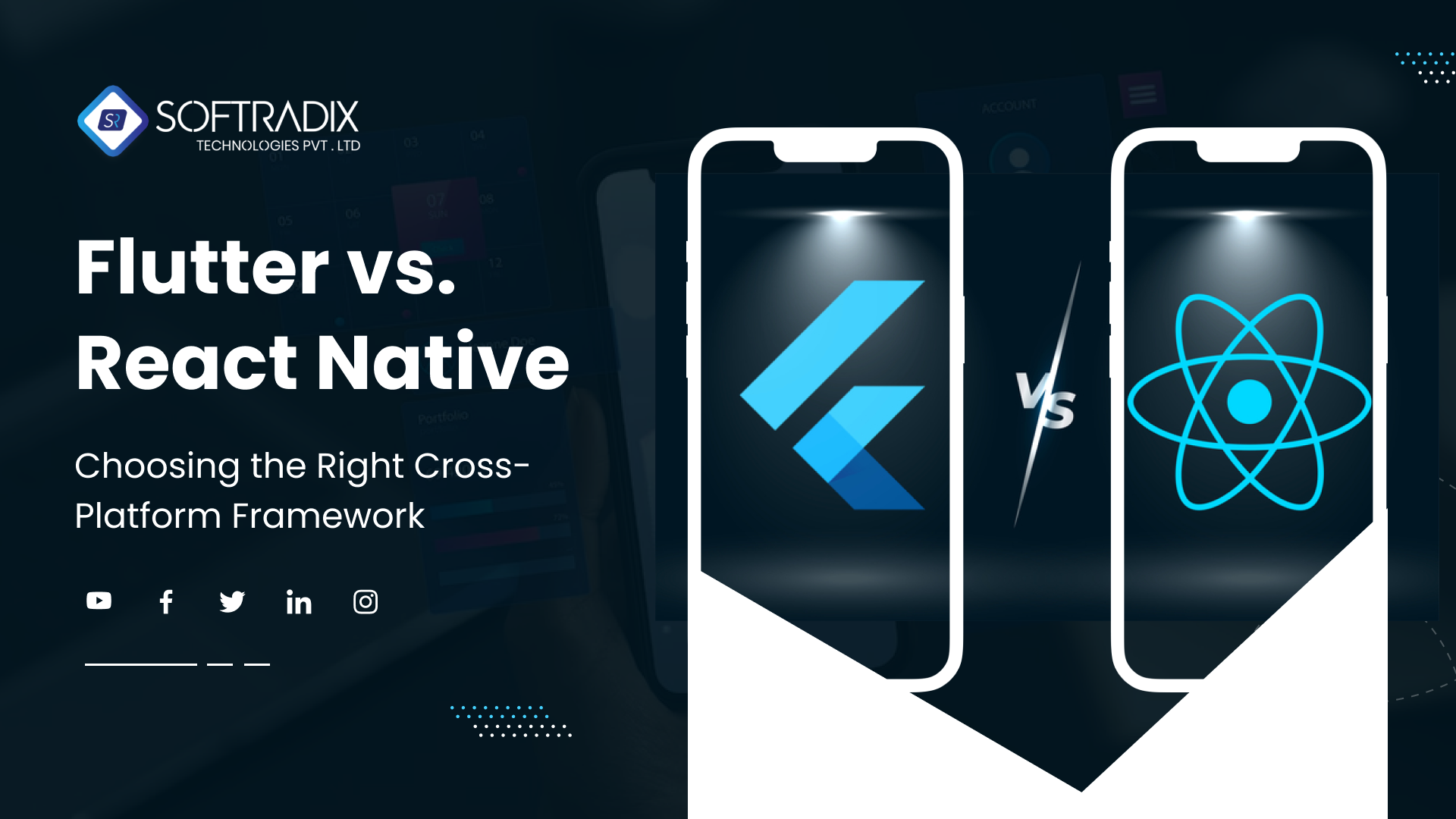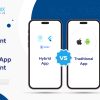
In today’s mobile-oriented world, we need to find efficient alternatives for developing applications that are able to gain a larger user base. Cross-platform frameworks provide an attractive answer as developers can build Android and iOS apps with a single codebase which means quicker time to development, reduced costs and simpler app maintenance. Yet among the variety of modern cross-platform tools, selecting an appropriate one is quite daunting. The most highly acclaimed cross-platform development platforms at the moment are Flutter and React Native. This article will delve into details by comparing Flutter vs React Native. Hopefully, it’ll help you find out which suits your project better.
Cross-platform frameworks are the layers that lie between the native development languages that include Java/Kotlin for Android and Swift/Objective-C for iOS, and the developer. This abstraction means that the developers may write a code once and then create an application that will run on both Android and IOS. While there are various alternatives to achieve cross-platform development, two dominant paradigms have emerged:
- Hybrid Frameworks: They rely on HTML, CSS and TypeScript to develop the user interface of the application or the game. The UI elements are then enclosed in native containers so that they can embrace the functionalities of the device. Some of the Hybrid frameworks are Apache Cordova and Ionic.
- Cross-Platform with Native Rendering: These frameworks work based on a single code base created in a language like Dart (Flutter) or TypeScript (React Native) to implement the application logic part. Nevertheless, they are used in contrast to general hybrid frameworks, which do not involve web views. Instead, they compile the code into the machine code specific to each platform to provide better outcomes with less difference in appearance from the native applications.
Flutter: A Development Toolkit
Flutter is a framework that was developed almost 7 years ago but it received a blast of growth in a short period of time because it is an open-source tool. It uses the Dart programming language which is among the simplest programming languages to learn in addition to being very legible. Here’s a closer look at Flutter’s key characteristics:Here are the details of Flutter characteristics:
- Widgets: Flutter comes with a variety of widgets that are already developed and are available to be incorporated in one’s application. Such widgets are highly optimized, and flexibility is also rather high, so it is possible to create rather attractive and beautiful infotainment UIs.
- Dart: It is a powerful, object oriented language syntactically as easy as Java or C#. Some of the features include the facility of hot reload which helps the developers to witness the modifications which have been made to the User Interface of the app when opened by the user almost instantaneously and therefore, the speed of app development will be enhanced.
- Skia Graphics Engine: Flutter has its own rendering engine named something like Skia which is best for animations and graphics and is also best when it comes to crossing for different devices. T This eliminates the reliance on platform-specific UI components, leading to a more consistent user experience.
- Single Codebase: Being a cross-platform framework, the flutter allow developers to write a piece of code and can be used on Android as well as on iOS. This reduces development time, and maintenance costs.
- Steep Learning Curve: Compared to other programming languages, Dart is relatively easy to learn, and most developers can become proficient within a week or two of practice. However, if you are a TypeScript developer you may take slightly longer to be able to do the same.
- Large App Size: This is because of the engine Skia and the fact that there is an available extensive widget library where Flutter app size can be significantly larger than the application built through react native.
React Native: Need TypeScript Expertise
React Native (RN) is an open-source cross-platform framework developed by Facebook. It is a stable and popular framework that uses TypeScript and React for building user interfaces across different platforms. Here are the core features of React Native:
- TypeScript: React Native uses TypeScript which is easily understandable for many developers with background in web development. This also provides ease for web developers to move into developing mobile apps and quick entry of more developers with TypeScript skills.
- React: Expanding on the successful React library design, React Native uses components to support the structure and identify of the actual code and make reusability less complicated. It is easier for the developers who are already working with React to work on React Native since the development style is somewhat similar.
- Native UI Components: Contrary to Flutter, React Native utilizes native UI widgets for every of the operating systems such as the Android and iOS. This can result in a feel closer to native apps and, perhaps, even smaller app sizes compared to Flutter.
- Large Community & Ecosystem: With the active community and a numerous number of libraries and plugins React Native provides a large amount of support and solutions to different tasks.
- Limited Customization: Customization is relatively flexible in React Native compared to Flutter due to the nature where it is not fully widget based as Flutter.
Choosing the Right Framework: Flutter vs. React Native
We have a good understanding of both Flutter and React Native. So, let’s delve into the factors that can support your decision on which framework to choose for your project. Here’s a breakdown of key considerations:
- Project Requirements:
-
- App Complexity: For complex applications with rich animations, heavy UI customization, or demanding performance needs, Flutter might be a better choice due to its powerful Skia graphics engine and comprehensive widget set.
- Native Feel and Performance: If a truly native-like experience and peak performance are top priorities, native development for each platform (Android and iOS) remains the ultimate solution. However, for projects where a near-native experience suffices, both Flutter and React Native can deliver excellent results.
- Development Team Expertise: If your team has a strong background in TypeScript and React, React Native might offer a smoother learning curve. However, if you’re open to exploring a new language or have a team comfortable with object-oriented programming, then Dart and Flutter can be compelling options.
- Development Speed and Cost:
-
- Time to Market: They both have rather large advantages when it comes to time needed for development that is one major benefit than native applications development. Still, due to the hot reload feature and sharing the same codebase Flutter could be marginally more efficient in the development process, particularly for applications with intricate designs.
- Maintenance Costs: Since, both these frameworks share the same code base it is feasible to assume that in terms of the cost of maintenance, both these frameworks are capable of coming up with much lower costs than that of native development. However, the cost will continue with the regular contribution with the complexities of the application and the necessity of specific platform-specific fixes.
- Other Considerations:
-
- Learning Resources: It is also important to note that when it comes to resources, both Flutter and React Native boast robust online learning which includes tutorials, documentation, and forums. Though, React Native can claim that it has some advantages, namely a bigger community and more time in development.
- Future-Proofing: To the best of the researcher’s knowledge they are both open source projects and have continuous active development. Nevertheless, Flutter may provide a more significant vision and better prospects because it is regarded as Google’s project.
Conclusion
Thus, it can be stated that Flutter and React Native are equally effective for developing excellent cross-platform mobile apps. Unfortunately, there is no universal ‘best’ framework for all environments. However, the choice is more subjective and depends on certain conditions such as the project itself, the competencies of the staff and the values that are important in a particular situation. Here’s a quick summary to aid your decision:
Choose Flutter if:
- Your app demands high performance and rich UI animations.
- Extensive UI customization is a priority.
- You’re open to learning a new language (Dart).
- Faster development speed with hot reload is crucial.
Choose React Native if:
- Your team has strong TypeScript and React experience.
- A truly native-like feel is less critical.
- A larger developer pool and extensive ecosystem are important.
- Smaller app size is a major concern.
Therefore, it can be concluded that the only meaningful approach is to try out both models and determine which one suits your project’s objectives and your team’s capacity to implement the framework best. It is recommended to use each framework to create a minimum viable product and understand its development approach and speed.
Examining and analyzing the previously mentioned factors and using the available resources one can confidently select the most suitable cross-platform framework to develop the mobile application to bring it to life.






